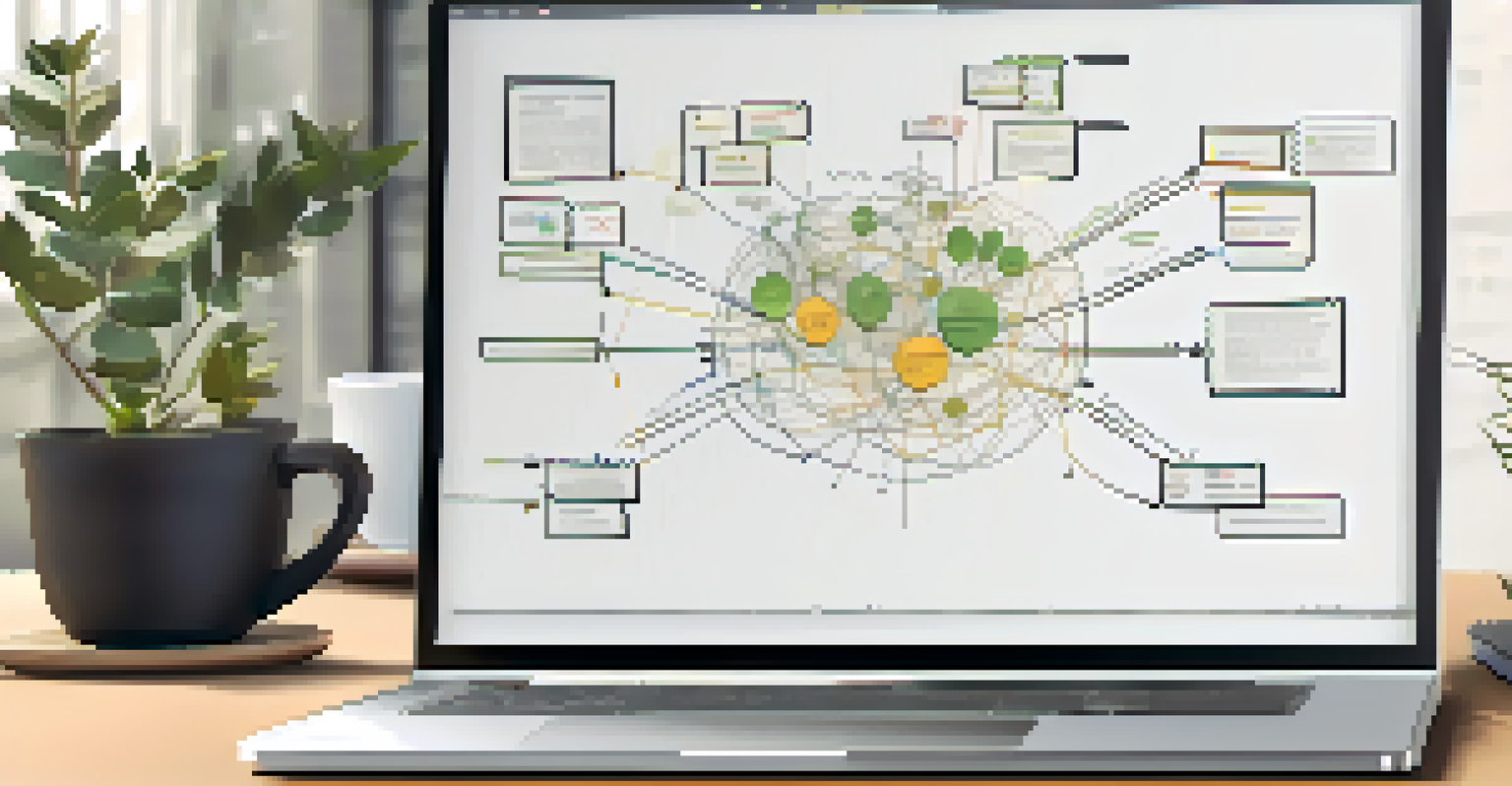Utilizing Mind Mapping Techniques to Alleviate Work Stress

Introduction to Mind Mapping and Its Benefits
Mind mapping is a visual tool that helps organize thoughts and ideas. It allows you to break down complex information into manageable parts, which can be especially helpful in a busy work environment. By visually mapping out tasks and ideas, you can see connections and relationships that might otherwise go unnoticed.
The mind is everything. What you think you become.
The benefits of mind mapping extend beyond just organization; it can also alleviate stress. When your thoughts are scattered, it can feel overwhelming, leading to increased anxiety. Mind maps help streamline your thinking process, making it easier to focus on what's important.
Moreover, mind mapping encourages creativity and problem-solving. When you're under pressure, finding innovative solutions can be challenging. A mind map allows you to explore different angles and perspectives, leading to fresh ideas that can reduce work-related stress.
How Mind Mapping Reduces Overwhelm
Feeling overwhelmed is a common experience in the workplace. With numerous tasks and deadlines, it's easy to lose sight of priorities. Mind mapping helps combat this by providing a clear visual representation of your responsibilities, making it easier to prioritize tasks.

By breaking down larger projects into smaller, actionable steps, mind mapping transforms daunting tasks into achievable goals. For example, if you're working on a presentation, you can create branches for research, design, and practice, allowing you to tackle one thing at a time without feeling swamped.
Mind Mapping for Stress Relief
Mind mapping helps organize thoughts visually, reducing overwhelm and promoting focus in a busy work environment.
This structured approach not only aids in organization but also fosters a sense of control. When you can clearly see what you need to do, you're less likely to feel paralyzed by the workload. In turn, this clarity can significantly reduce stress levels.
Enhancing Creativity Through Mind Mapping
Creativity often takes a hit when stress levels rise. Mind mapping can serve as a catalyst for creative thinking, helping you break free from mental blocks. By allowing your ideas to flow freely on paper, you can explore new concepts without judgment.
You can’t use up creativity. The more you use, the more you have.
Consider brainstorming a new project; a mind map lets you jot down every idea that comes to mind, no matter how unconventional. This unrestricted approach not only sparks creativity but also reduces the pressure of trying to come up with the 'perfect' idea right away.
Furthermore, the visual nature of mind maps can inspire connections between seemingly unrelated topics. This can lead to innovative solutions and fresh perspectives, alleviating the stress that comes with feeling stuck or uninspired.
Setting Clear Goals with Mind Mapping
Setting clear goals is essential for managing work-related stress. Mind mapping allows you to define your objectives visually, making them more tangible and achievable. By creating a central goal and branching out with specific tasks, you give yourself a roadmap to follow.
For instance, if your goal is to improve team collaboration, you can create branches for communication strategies, team-building exercises, and regular check-ins. This clarity not only helps you focus on what's important but also provides a sense of accomplishment as you complete each task.
Boosting Creativity with Mind Maps
By allowing ideas to flow freely, mind mapping enhances creativity and problem-solving by connecting unrelated concepts.
Moreover, having clearly defined goals reduces ambiguity, a common source of stress. When you know what you're working towards, it's easier to stay motivated and on track, which can significantly decrease feelings of overwhelm.
Using Mind Maps for Effective Time Management
Time management is crucial for reducing work stress. Mind mapping can help you visualize how to allocate your time more effectively. By mapping out your tasks and their associated time requirements, you can create a realistic schedule that balances work and breaks.
For instance, you could create a mind map that outlines your daily tasks, assigning time blocks for each one. This approach not only helps you stay organized but also allows for flexibility, as you can quickly adjust your plan if something unexpected arises.
Additionally, seeing all your tasks laid out can help you identify which ones are taking more time than necessary. By recognizing these patterns, you can make adjustments to improve your efficiency, ultimately reducing stress.
Collaborative Mind Mapping to Foster Team Support
Workplace stress can often stem from a lack of support or communication among team members. Collaborative mind mapping is an excellent way to foster teamwork and ensure everyone is on the same page. By creating a shared mind map, team members can contribute their ideas and insights.
This collaborative effort not only enhances communication but also builds a sense of community. When everyone has a voice in the planning process, it can lead to a more cohesive team environment, reducing the stress that comes with isolation or miscommunication.
Collaborative Mind Mapping Benefits
Creating shared mind maps fosters teamwork and communication, reducing stress and enhancing problem-solving capabilities.
Moreover, collaborative mind mapping can be a powerful tool for problem-solving. By pooling together different perspectives, teams can explore various solutions to challenges, alleviating the pressure and stress of navigating obstacles alone.
Tips for Implementing Mind Mapping in Your Routine
Incorporating mind mapping into your daily routine doesn't have to be daunting. Start small by dedicating a few minutes each day to jot down your thoughts or tasks in a mind map format. Over time, you'll find it becomes a natural part of your workflow.
Consider using digital tools or apps specifically designed for mind mapping. These can make the process more interactive and accessible, allowing you to easily edit and reorganize your ideas as needed. Plus, they often come with templates to get you started quickly.

Finally, don't hesitate to experiment with different styles of mind mapping. Whether you prefer colorful diagrams or simple lists, find what works best for you. The key is to make it a personalized tool that genuinely helps reduce your work stress.